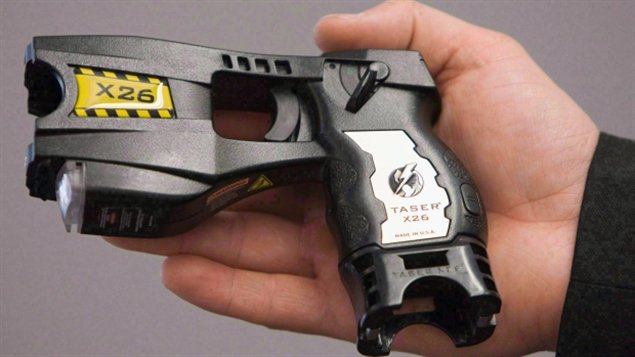A new Canadian study says there are big gaps in scientific information about the health risk of stun guns, widely used by police.
Stun guns are more properly known as “conducted energy weapons” (CEW) although the biggest manufacturer’s product, Taser, has almost become a popular generic term.
The idea is to give police a non-lethal alternative when attempting to subdue an individual. However there have been a number of deaths associated with stun gun use which has prompted the investigation.
The study by the Council of Canadian Academies is called “The Health Effects of Conducted Energy Weapons”
The report says while there is a potential for fatal respiratory and/or cardiac complications in people, that risk is “extremely rare”. It adds that while stun guns are supposed to be a safe, potentially injury-free alternative, they are not however, necessarily risk-free.
In addition, the panel’s report adds concerns that there are large gaps in information preventing making any definitive claims one way or the other about the weapons and adverse health effects. The report says much more information is needed to determine any such relationship.
It notes for example that tests of such weapons are done on computers, on animals and on healthy physically fit volunteers. While these controlled settings are of interest, the panel says this does not provide useful data on the real world use and the vast number of variables and the effects on individuals hit by CEW’s.
- Stun guns deliver short, repeated high voltage pulses of electricity to the skin and subcutaneous tissues through two metal probes fired by compressed air up to 10 metres away. They can be used in two operating modes: probe mode and drive stun mode. In probe mode, a pair of metal darts deploys from the CEW, spreads apart, and penetrates the subject’s clothing, skin, and soft tissues. The darts are connected to thin electrical wires that conduct the electrical discharge from the device. In drive stun mode, the device is pressed directly against the subject, causing localized pain. Probe mode is more likely to result in current flow through the tissues in the chest — including, potentially, the heart — and carries the most risk of unwanted cardiac or other health effects.
The 14-member panel of experts also noted the difficulty in trying to establish a causal relationship between CEW use and later sudden in-custody death.
They said a number of potential factors including such things as stress, drug and/or alcohol use, pre-existing health conditions, and others make it difficult to determine if a CEW was the primary factor in sudden in-custody deaths, or how a CEW may have exacerbated a pre-existing condition
The Council says there is a lack of standardization in a number of ways, not the least of which is inconsistent reporting and record-keeping practices. This limits the ability to conduct population-based studies (real world events) and gather evidence-based conclusions about stun gun use and adverse health effects. It recommends standarized record keeping of all CEW incidents, not only from police but from medical professionals as well, and information sent to a centralized recording agency.
It also notes that many of the available studies are affiliated with or received support from CEW makers. The Council says, while such testing may be scientifically valid, even the perception of conflict of interest clouds the results. It says independent testing with no direct or indirect connection to CEW makers is needed.
It concludes that there are still major gaps in data on the physiological and health effects of CEW’s, but there are also other considerations that go into the assessment of CEW use, and as such the report should only be considered as a complement to other studies on testing and approval, and protocols for appropriate use. The Council report says while public perception is important, it should not lead the debate which should be guided by scientific inquiry.risk assessment and evidence.
- -There are approximately 9,174 conducted energy weapons or stun guns in use in Canada.
- -Since the late 1990s, at least 33 people have died following their use.
- -Taser is an acronym for “Thomas A Swift Electric Rifle”, named after Tom Swift a fictitious young inventer featured in anamed after a series of children’s science-fiction novels written in the early 20th century
The Council of Canadian Academies is an independent, non-profit organization that works to provide information for public policy development. The Canadian Academy of Health Sciences is an independent assessor of science and technology issues relating to health.







For reasons beyond our control, and for an undetermined period of time, our comment section is now closed. However, our social networks remain open to your contributions.